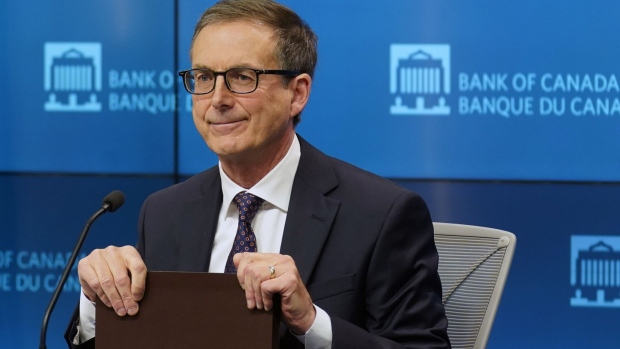Canadian hiking path hinges on business investment: Macklem - BNN - 3 minutes read

Bank of Canada Governor Tiff Macklem indicated the future path of interest-rate increases will depend in part on whether the nation’s businesses ramp up investment as the economy emerges from the pandemic.
In a speech two weeks after holding rates at emergency lows, Macklem promised Wednesday he would “act deliberately and communicate clearly” as he begins to raise borrowing costs. But he made clear that businesses have a role in determining how smooth the process will be.
“Productivity growth is vital to non-inflationary growth and rising standards of living,” Macklem said, in prepared remarks of his speech to the Canadian Chamber of Commerce. “At a time when inflation is already well above our target, this is more vital than ever.”
At its Jan. 26 policy decision, the Bank of Canada said it would be raising borrowing costs soon to cool inflation. Markets are fully pricing in a hike at the central bank’s next decision on March 2, with as many as six more priced in over the next year.
The comments are consistent with testimony Macklem gave to lawmakers in the Senate last week when he said the rate path will hinge in part on business investment. The Canadian dollar was little changed after the speech, up 0.3 per cent to CUS$1.267 per U.S. dollar at 12:37 p.m. in Toronto trading.
At a press conference after the speech, Macklem said the Bank of Canada won’t be on “autopilot” as it raises interest rates, and policy makers will gauge the appropriateness of policy settings “at each point.” He said that all else being equal, the less business investment there is, the higher interest rates will need to go.
The governor noted, however, that the bank won’t have a good understanding how high borrowing costs will need to rise until the process begins. “We’re going to see how the economy reacts to higher interest rates,” Macklem said.
In the speech, Macklem said the surge in demand for goods during the pandemic is responsible for much of the pick-up in prices, and those forces should fade enough to bring inflation back down to about 3 per cent by the end of this year. In December, consumer price gains hit 4.8 per cent, the highest in three decades.
The higher inflation “is not the result of generalized excess demand in the Canadian economy,” Macklem said. “Our economy is only just now getting back to full capacity.”
Higher interest rates, however, are needed to bring inflation back to the central bank’s 2 per cent target. Macklem sought to reassure the business community that the central bank is committed to that goal.
“As businesses set prices and wages, firms and workers alike can be assured that the Bank of Canada will use its monetary tools to control inflation,” he said.
Macklem also provided some of the underlying thinking behind the Bank of Canada’s latest economic projections, which include an assumption the nation will be able to produce strong growth over the next two years without stoking inflation. That’s because the bank is expecting a rebound in lagging business investment numbers, Macklem said.
While Canadian corporate spending has lagged the U.S. during the pandemic, it’s expected to accelerate as the country’s COVID-19 containment restrictions are lifted, Macklem said.
“Indeed, we expect that business investment will grow faster in Canada than in the United States,” he said. “It’s imperative that businesses in Canada follow through on these plans or risk losing out to US competitors.”
Source: BNNBloomberg.ca
Powered by NewsAPI.org